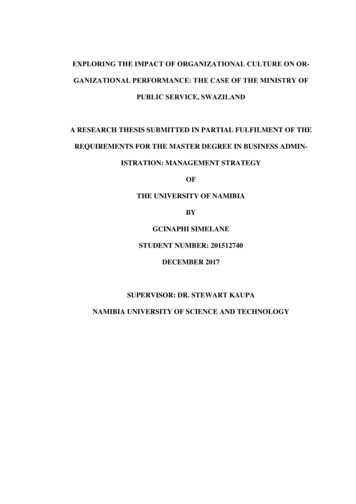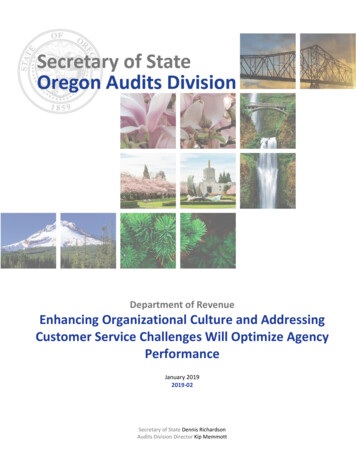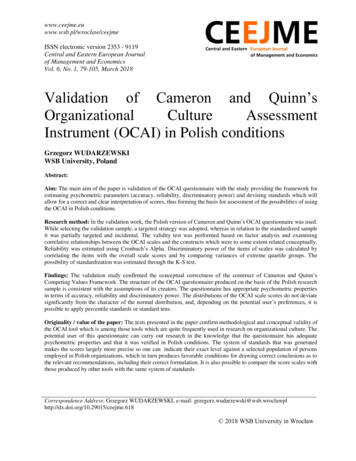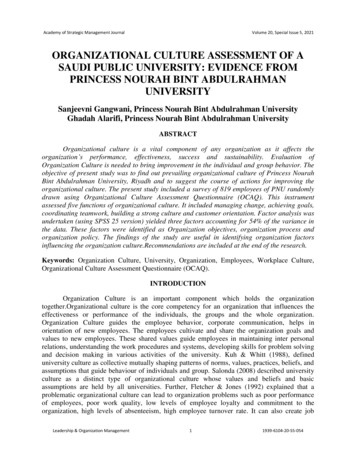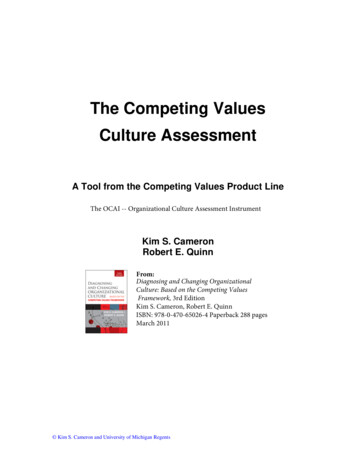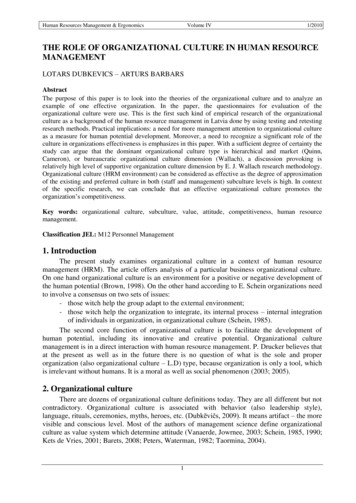
Transcription
Human Resources Management & ErgonomicsVolume IV1/2010THE ROLE OF ORGANIZATIONAL CULTURE IN HUMAN RESOURCEMANAGEMENTLOTARS DUBKEVICS – ARTURS BARBARSAbstractThe purpose of this paper is to look into the theories of the organizational culture and to analyze anexample of one effective organization. In the paper, the questionnaires for evaluation of theorganizational culture were use. This is the first such kind of empirical research of the organizationalculture as a background of the human resource management in Latvia done by using testing and retestingresearch methods. Practical implications: a need for more management attention to organizational cultureas a measure for human potential development. Moreover, a need to recognize a significant role of theculture in organizations effectiveness is emphasizes in this paper. With a sufficient degree of certainty thestudy can argue that the dominant organizational culture type is hierarchical and market (Quinn,Cameron), or bureaucratic organizational culture dimension (Wallach), a discussion provoking isrelatively high level of supportive organization culture dimension by E. J. Wallach research methodology.Organizational culture (HRM environment) can be considered as effective as the degree of approximationof the existing and preferred culture in both (staff and management) subculture levels is high. In contextof the specific research, we can conclude that an effective organizational culture promotes theorganization’s competitiveness.Key words: organizational culture, subculture, value, attitude, competitiveness, human resourcemanagement.Classification JEL: M12 Personnel Management1. IntroductionThe present study examines organizational culture in a context of human resourcemanagement (HRM). The article offers analysis of a particular business organizational culture.On one hand organizational culture is an environment for a positive or negative development ofthe human potential (Brown, 1998). On the other hand according to E. Schein organizations needto involve a consensus on two sets of issues:- those witch help the group adapt to the external environment;- those witch help the organization to integrate, its internal process – internal integrationof individuals in organization, in organizational culture (Schein, 1985).The second core function of organizational culture is to facilitate the development ofhuman potential, including its innovative and creative potential. Organizational culturemanagement is in a direct interaction with human resource management. P. Drucker believes thatat the present as well as in the future there is no question of what is the sole and properorganization (also organizational culture – L.D) type, because organization is only a tool, whichis irrelevant without humans. It is a moral as well as social phenomenon (2003; 2005).2. Organizational cultureThere are dozens of organizational culture definitions today. They are all different but notcontradictory. Organizational culture is associated with behavior (also leadership style),language, rituals, ceremonies, myths, heroes, etc. (Dubkēvičs, 2009). It means artifact – the morevisible and conscious level. Most of the authors of management science define organizationalculture as value system which determine attitude (Vanaerde, Jowrnee, 2003; Schein, 1985, 1990;Kets de Vries, 2001; Barets, 2008; Peters, Waterman, 1982; Taormina, 2004).1
Human Resources Management & ErgonomicsVolume IV1/2010Values are defined as ideas and objects with a special meaning on a personal as well asorganizational level (Dubkēvičs, 2009). They determine basic assumptions about the reality,human nature and relationships. Attitude is valuation. It is described by a cognitive aspect(positive or negative views), affective aspects (emotions and feelings), and behavioral aspects(specific actions) towards persons and objects (Warr, 2002).Edgar Shein is the author of the most popular organizational culture definition:„Organizational Culture is „ a pattern of basic assumption – invented, discovered, ordeveloped by a given group as it learns to cope with its problems of external adaptation andinternal integration – that has worked well enough to be considered valid and therefore, to betaught to new members as the correct way to perceive, think, and feel in to those problems”,(1985, p. 9).Organizational culture is a complex phenomenon. Therefore management science musttake into account insights from different social sciences: sociology, anthropology, psychologyand philosophy. G. Hofstede and G. J. Hofstede believe that the relationship between society,organization and individual is just as natural as link between “a garden, a bouquet of flowers anda flower”, (2005, p. 304).Organizational culture research requires an integrative approach. In near as well as distantfuture innovation most likely is expected in “parallel worlds” – contact of various social sciencesin sensitive and so creative points. Most famous bipolar classifications of the organizationalculture are: strong/weak, functional/dysfunctional, efficient/inefficient, positive/negative cultures(Dubkēvičs, 2009). T. Deal and A. Kennedy determined five major signs of a weakorganizational culture:- unclear, inadequately identified value system;- organization has no internal consensus on how they reach their targets and whatinstruments they use;- existing subcultures in the organization have different views;- ineffective leadership;- ceremonies and rituals are disorienting, even contradictory (Deal, Kennedy, 1982).Weak organizational cultures are characterized by a high level of cultural entropy – aproportion of energy wasted on non-productive activities by a group of people (Barets, 2008).Weak organizational culture indicates a weak human resource management (HRM). Anyorganizational culture consists of subcultures. Subcultures are relatively independent systems ofvalues, norms and behavioral stereotypes that exist in a cultural context and are not in a sharpconflict with it (Zepa, 1997). E. Schein determines three general subcultures which exist in everyorganization:- subculture of employees;- subculture of creators;- management (leadership) subculture (Schein, 1985).Leadership issues are functionally important for shaping and managing the organizationalculture – leadership in organization defines the culture. M. Kets de Vries compares organizationswith cars: driverless cars run only downhill. People are necessary for cars to really work and theright people by the steering wheel (Kets de Vries, 2001). On the other hand – leadership is agroup phenomenon. It is popularly argued that human resource professionals are able to play animportant role in managing key elements of culture (symbols, rites, rituals, norms of behavior,beliefs, values and assumptions).Therefore in the context of this paper, the study is based on a diversion between staff andleadership subcultures. It determines the basic research criteria for organizational cultureevaluation:2
Human Resources Management & ErgonomicsVolume IV1/2010- typological matching degree of the organizational culture on staff and leadershipsubculture levels;- degree of approximation between the existing and the preferred organizational culturemodels in both subcultures;- degree of approximation of the organizational culture values in both subcultures.This research is based on assumptions that effective organizational culture is characterizedby a high degree of approximation between subcultures in all levels of research criteria.3. Organizational culture typology theoriesToday there are about one and a half dozen of typological theories. R. Quinn and K.Cameron determine four basic types of organizational culture:- hierarchy culture;- market culture;- clan culture;- adhocracy culture.This typology is based on four criteria: flexibility and discretion; stability and control;external focus and differentiation; internal focus and integration (Figure 1).Flexibility and discretionClanAdhocracyExternal focusanddifferentiationInternal focusand integrationHierarchyMarketStability and controlFigure 1: Competing Values FrameworkSource: Cameron, Quinn, 1999, p. 32Each organizational culture type is characterized by a certain type of competing values,which in turn describe the environment of HRM (Cameron, Quinn, 1999). In terms of typology itis very similar to E. Wallach theory (Wallach, 1983). E. Wallach uses a term “culturaldimensions” to emphasize that the cultures are not monolithic, but multidimensional subculturephenomenon and that we can only talk about the dominants. This author determines three maincultural dimensions:- bureaucratic;- innovative;- supportive.3
Human Resources Management & ErgonomicsVolume IV1/2010Difference between opinions of the authors is more terminological. The similarity of boththeories is reflected in Table 1.Table 1: Characterization of K. Cameron, R. Quinn and E. Wallach organizational culturetypes/dimensionsOrganizationalculture types byK. Cameron andR. QuinnHierarchy (similar tomarket butcharacterized with astronger marketorientation)Organizationalculture dimensions byE. WallachCore values of theorganizational culture(HRM environment)Individual motivationfor development ofthe of humanresource potential(McClelland, 1967)BureaucraticEfficiency, resultsorientation, stability,power, control, loyalty,competitionPowerAdhocracyInnovativeClan (family typeculture)SupportivePersonal creativefreedom, orientationtowards change,innovation, riskUnity (“we”consciousness), team,loyalty, mutual respect,trust, trust in traditionAchievementAffiliationSource: own comparisonTable 1 also includes individual motivation, which is one of the key components of HRM.Each type of the organizational culture determines the HRM model. Even more – allorganizational culture types must be integrated into the preferred human resource managementas subcultures.In the human resource potential development context of organizational culture, the valueemotional aspects are of a particular importance. In the organizational culture where emotionsare not appreciated, there is a risk of alexotimical human resource environment, characterized byroutine, schematic thinking, low productivity and the burn out syndrome. Organizations with alow level of emotional intelligence are not creative. Recently terms like emotional company andE (emotional) business have emerged in the business vocabulary (Dubkēvičs, 2009). This showsthat the role of emotions is being recognized in organizations.4. Realized questionnaire surveyIn realized survey, all 84 respondents (20 male, 64 female) were working adults aged from23 to 62. Majority (76%) are female. Majority of respondents are in the age group from 31 to 45(45%) All the respondents who participated in the research were split into two groups – staff andmanagement. Also results are show for each group separately. Majority (69%) of respondentsrepresent the management (58) – mainly middle level managers, while 31% represent staff (26).All the respondents present a sufficient level of confidence.Measures:1. The main instrument used for measuring the organizational culture was the OrganizationalCulture Assessment Instrument (OCAI) by K. Cameron and R. Quinn. The questionnairecontains 6 questions. For each question there are four answers. Respondents have to divide100 points among the 4 alternatives. Questionnaire allows to determine the dominantorganizational culture type, the degree of approximation of the existing and preferred culture4
Human Resources Management & ErgonomicsVolume IV1/2010and hence its effectiveness. The questionnaire also measures the human resourcemanagement. It links organizational culture with the HRM.2. The organizational culture was also measured by using E. Wallach (Wallach, 1983) 24-itemOrganizational Culture Index (OCI), which profiles the culture into three dimensions –bureaucratic, innovative and supportive. Using a four-point scale (1 Does not describe myorganization, to 4 Describes my organization most of the time), respondents were asked toassess how well the adjectives describe their company. OCI was used as a test and retestmethod for OCAI. This instrument allows determining the dominating cultural type and theeffectiveness.Assumptions of the study:1. In the specific organizational culture research authors have used two different researchinstruments based on similar theoretical concepts. It can therefore be assumed that the resultscorrelated with one another.2. Organization selected for the study is one of the leaders in the commercial banking sector. Itcan be assumed that the indicator of organizational effectiveness is an effective organizationalculture, characterized by high degree of approximation in regards to existing and preferredculture models.Results:The OCAI responses from both Management (see Table 3 and Figure 3) and Staff (seeTable 2 and Figure 2) were summed to find an averaged response for the existing and preferredculture profiles. The existing and preferred culture results are shown on the competing valuesframework. Each line represents 5 points.Table 2: Organizational culture from perspective of staff ource: ownStaff preffers the hierarchy culture which according to the questionnaire currently is theexisting culture. Hierarchy culture is characterized as a very formalized and structured place towork. There are written procedures that govern what people do. Such formal rules and policieshold the organization together. The long term target in such organization is stability andperformance with efficient operations. Stability of course is one of the most important parts ofbanking business. Employees also appreciate the security of employment and predictability ofsuch an organization.Even though the hierarchy culture is still dominating in existing as well as preferredorganizational culture, research shows that staff would preffer the organizational culture to bemore balanced between all the organizational culture types.5
Human Resources Management & ErgonomicsVolume IV1/2010Figure 2: Culture profile 1Source: ownManagement showed (see Table 3 and Figure 3) an interest in transforming from hierarchyculture, which is the current state, to as a clan culture. Both hierarchy culture and clan culture arefocused on internal maintanance. While the hierarchy culture is a very formalized and structuredworking place with a need for stability and control, clan culture is a very friendly working placewhere people share themselves. It is like an extended family where leaders are considered to bementors and even parent figures. The clan culture organization is held together by loyalty andtradition. The organization places a premium un teamwork, participation and consensus.Table 3: Organizational culture from perspective of management 25.13Source: own6
Human Resources Management & ErgonomicsVolume IV1/2010Figure 3: Culture profile 2Source: ownTable 4: Existing organizational culture from perspective of staff and management ff22.6319.4224.4233.4Source: ownFigure 4: Culture profile 3Source: own7Management26.3216.7523.4533.65
Human Resources Management & ErgonomicsVolume IV1/2010Analysis of the existing organizational culture show that both – staff and management seethe dominating organizational culture type as the hierarchy culture (Table 4 and Figure 4). Thereis a difference in regards to the second dominating culture which management see as clan culturewhile staff see the market culture as second dominating. It shows that staff as well asmanagement believe that the organization is based on stability, formal rules and policies.Mismatch between staff and management opinions is where management see the organization asa family of loyal and self motivated people while staff see it as a group of competitive and goaloriented people with tough and demanding leaders.There is a mismatch in regards to preferredculture between staff and mangement (Table 5 and Figure 5). Staff preferrs hierarchy culturewhile the management prefers clan culture. It shows that staff has accepted the existingdominating organizational culture type as the most suitable for orgaization in question. Frommanagement perspective clan culture should be dominating in the preferred organizationalculture. Management would like the organization to be more people oriented and based more ontrust than on control.Table 5: Preferred organizational culture from perspective of staff and management .13Source: ownFigure 5: Culture profile 4Source: ownE. J. Wallach survey results show similar organizational culture dominants on staff as wellas managerial level.8
Human Resources Management & ErgonomicsVolume IV1/2010Both staff and management recognize the bueraucratic organizational culture as thedominant with more than 26 points (Figure 6). The bueraucratic organizational culture ischaracterized as hierarchical. There are clear lines of responsibility and authority. Work is wellorganized and systematic. Such culture is usually based on control and power. It is also poweroriented, cautious, established, solid, regulated, ordered, structured, procedural and hierarchical.A well trained staff and sound structure with efficient systems and procedures make it work.Strong bueraucratic culture is not likely to attract and retain creative or ambitious people. Seconddominating culture in the organization in question is the supportive culture. It is characterized asa very warm place to work. It is almost like an extended family of friendly and helpful people.Figure 6: Organizational culture from perspective of staff and management subculturesSource: ownThere is no significant mismatch between the dominant organizational culture type fromstaff and management perspective.5. Conclusions and implicationsWith a sufficient degree of certainty the study can argue that the dominant organizationalculture type is hierarchical and market (Quinn, Cameron), or bureaucratic organizational culturedimension (Wallach), a discussion provoking is relatively high level of supportive organizationculture dimension by E. J. Wallach research methodology.Organizational culture (HRM environment) can be considered as effective as the degree ofapproximation of the existing and preferred culture in both (staff and management) subculturelevels is high. In context of the specific research, we can conclude that an effectiveorganizational culture promotes the organization's competitiveness.In the perspective research base needs to be expanded for the assessment of the specificbusiness sector in Latvia and in further perspective in the Baltic countries to promote humandevelopment and thereby enhance their competitiveness.References:[1] BARETS, R.: Vērtīborintētas organizācijas izveide: visas sistēmas kultūrastransformācijas koncepcija. Rīga. Biedrības Domas spēks. 2008. ISBN 978-99849961109
Human Resources Management & ErgonomicsVolume IV1/2010[2] BROWN, A.: Organizational Culture. New York. Prentice Hall. 1998. ISBN 9780273631477[3] CAMERON, S. K. – QUIT, R. E.: Diagnosing and Changing Organizational CultureBased on Values Framework. Addison – Wesley Publishing Company. Inc. 1999. ISBN978078798283[4] DEAL, T. E. – KENNEDY, A. A.: Corporate Culture: the Rites and Rituals of CorporateLife. Reading, Moss. Addison –Wesley. 1982. ISBN 9780738203300[5] DRUCKER, P. F.: Managing in the Next Society. Oxford. Butterworth – Heinemann. 2003.ISBN 9780312320119[6] DRUCKER, P.: Managing Oneself. In: Harward Business Review – Special Edition. January,2005, pp. 61-65. ISBN 978-1422123126[7] DUBKĒVIČS, L.: Organizācijas kultūra. Rīga. Jumava. 2009. ISBN 978-9984387024[8] HOFSTEDE, G. – HOFSTEDE, G. J.: Culture and Organizations: Software of the Mind.New York. McGraw-Hill. 2005, 304 p. ISBN 9780071439596[9] KETS DE VRIES, M. F. R.: The Leadership Mystique. London. Financial Times/PrenticeHall. 2001. ISBN 9780273656203[10] PETERS, T. J. – WATERMAN, R. H.: In Search of Excellence. Lessons from AmericasBest-Run Companies. New York. Harper&Row Publishers. 1982. ISBN 978-1402501814[11] SCHEIN, E. H.: Organizational Culture. In: American Psychologist. 1990, No. 45, pp.109-119. ISSN 0003-066X[12] SCHEIN, E. H.: How Culture Forms Develops and Changes. In: Kilmann, R. H. – Salon,M. J. – Serpa, R. et al.: Gaining Control of the Corporate Culture. San Francisco. JosseyBass. 1985, pp. 17-43. ISBN 9780875896663[13] MCCLELLAND, D. C.: The Achieving Society. New York. Free Press. 1967. ISBN9780029205105[14] TAORMINA, J. T.: Convergent Validation of Two Measures of OrganizationalSocialization. In: International Journal of Human Resource Management. 2004, Vol. 15.No. 1, pp. 76-94. ISSN 1466-4399[15] VANAERDE, P. – JOWRNEE, M.: Cultuurverandering. Antwerpen. Uitgeverij De Boeck.2003. ISBN 9045508702[16] WALLACH, E. J.: Individuals and organization: The Cultural Match. In: Training andDevelopment Journal. 1983, February, pp. 29-36. 0041-0861[17] WARR, P.: The Study of Well-being. Behavior and Attitudes. In Psychology at Work.London. Penguin Books. 2002, pp. 1-25. ISBN 9780141000107[18] ZEPA, B.: Socioloģijas skaidrojošā vārdnīca. Rīga. Latvijas Universitātes Socioloģijaskatedra. 1997. ISBN 9789984509860.Address of authors:Lotars DUBKEVICS, Mg. psych.BA School of Business and FinanceRigaLatviae-mail: lotars.dubkevics@ba.lvArturs BARBARS, BBABA School of Business and FinanceRigaLatviae-mail: arturs.barbars@gmail.com10
1. The main instrument used for measuring the organizational culture was the Organizational Culture Assessment Instrument (OCAI) by K. Cameron and R. Quinn. The questionnaire contains 6 questions. For each question there are four answers. Respondents have to divide 100 points among the 4 alternatives.




